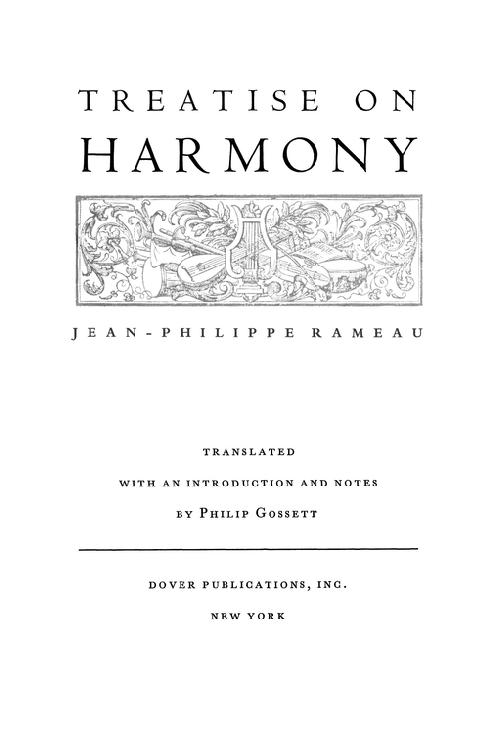
Copyright 1971 by Dover Publications, Inc.
All rights reserved under Pan American and International Copyright Conventions.
This Dover edition, first published in 1971, is a new English translation of Trait de lharmonie, printed by Jean-Baptiste-Christophe Ballard, Paris, 1722. An Introduction and Notes have been prepared by the translator, Philip Gossett.
9780486171371
Manufactured in the United States of America
Dover Publications, Inc., 31 East 2nd Street, Mineola, N.Y 11501
To Suzanne
TREATISE ON HARMONY
REDUCED TO ITS NATURAL PRINCIPLES
DIVIDED INTO FOUR BOOKS

BooK I: On the Relationship between Harmonic Ratios and Proportions.
BooK II: On the Nature and Properties of Chords; and on Everything which may be used to make Music perfect.
BooK III: Principles of Composition.
BooK IV: Principles of Accompaniment.
BY
MONSIEUR RAMEAU
Organist of the Cathedral of
Clermont in Auvergne.
FROM THE PRESS OF
JEAN-BAPTISTE-CHRISTOPHE BALLARD,
ONLY ROYAL PRINTER FOR MUSIC. PARIS, RUE
SAINT JEAN-DE-BEAUVAIS, at MONT-PARNASSE.

M. DCC. XXII.
WITH THE ROYAL PRIVILEGE.
TRAIT DE LHARMONIE
Reduite fes Principes naturels;
DIVIS EN QUATRE LIVERS.
LIVRE I. Du rapport des Raifons & Proportions Harmoniques.
LIVRE II. De la nature & de lapropriet des Accords; Et de tout ce qui peut fervir rendre une Mufique parfaite.
LIVRE III. Principes de Compofiition.
LIVRE IV. Principes dAccompagnement.
Par Mon  ieur RAMEAU, Organi
ieur RAMEAU, Organi  te dela Cathedrale de Clermont en Auvergne .
te dela Cathedrale de Clermont en Auvergne .
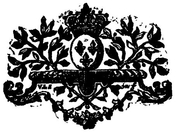
DE LIMPRIMERIE
De JEAN-BAPTISTE-CHRISTOPHE BALLARD, Seul Imprimeur du Roy pour la Mufique. A Paris, ru Saint Jean- de-Beauvais, au Mont-Parnaffe.
M. D C C. XXII.
AVEC PRIVILEGE DU ROT.
TRANSLATORS INTRODUCTION
Although the importance of the theoretical writings of Jean-Philippe Rameau has rarely been contested, until now these works have been relatively unavailable. The denseness of their prose style has contributed to their neglect by discouraging readers from gaining first-hand acquaintance with them. As a result the harmonic theories of Rameau are known primarily from modern textbooks and short summaries, where misunderstandings about the content of the treatises have often proliferated and where statements taken out of context, such as Melody is merely a part of harmony, have acquired meanings largely irrelevant to Rameaus thought.
This neglect is not a purely modern phenomenon. It is perhaps significant that not one of Rameaus treatises underwent a second edition, in striking contrast to many less important theoretical works of the early eighteenth century. A minor treatise cited several times by Rameau, the Nouveau trait des regles pour La composition. de la musique by Charles Masson, for example, was brought out in four separate editions between 1697 and 1738. This limited demand for the treatises of Rameau can be attributed in part to his prolific production of new treatises throughout his life, Personal malice entered into Rousseaus judgment, to be sure, for Rameau and Rousseau were bitter enemies, but the statement contains more than a modicum of truth.
It would be wrong to conclude that the significance of Rameaus treatises was not appreciated by his contemporaries. Indeed, these works were dissected, condensed, and rearranged in order to make them palatable to those unable to follow the tortuous lines of thought in the original books. The most famous of these glosses was by dAlembert, one of the editors of the Encyclopdie, who wrote an Elmens de musique thorique et pratique, suivant les principes de M. Rameau (1752) which underwent several editions. Even on the title page dAlembert insists that he will clarify, develop, and simplify the principles of Rameau.
The present edition makes available for the first time a complete English translation of Rameaus Trait de lharmonie, the first and most fundamental of his contributions to harmonic theory. It is a peculiar work, repetitious, often inconsistent, and lacking in clear organization, but a careful reading singles it out immediately as revolutionary in its approach to harmony. Rameau had not yet become aware of the overtone series, he had not yet formulated his theory of the subdominant, or crystallized many other elements of his theory, such as the double employment of chords, but his teachings on fundamental bass, chordal inversion, modulation, and chord-building by thirds are all stated clearly and completely in the Trait. Within the confines of the monochord, within the framework of medieval theory, Rameau here constructed and rationalized a theory of tonality which was to remain basic for Western music during the next two centuries.
There exist already several summary accounts of Rameaus theories and an excellent biographical study. Instead of duplicating these works, then, I shall concentrate in this introduction on various specific problems relating to the Trait.
PUBLICATION HISTORY
No modern edition exists of any of Rameaus major theoretical works. It is only now that a complete facsimile edition of all the writings of Rameau is being undertaken by Professor Erwin Jacobi. The Trait de lharmonie was first published in 1722. Book III of the Trait was translated into English soon after as A Treatise of Musick, containing the Principles of Composition [London, 1737], revised in 1752. Book IV was separately published in an English translation by Griffith Jones toward the end of the eighteenth century as A Treatise on Harmony in which the Principles of Accompaniment are fully explained (n.d.). Books I and II have never been rendered into English and the early translations of Books III and IV are of only limited interest today. They were intended primarily as practical manuals, so that the text is rendered quite freely, sections being omitted or completely changed to meet presumably pedagogic needs.
Three existing copies of the Trait pose special bibliographic problems. The first, a copy owned by Mr. Andr Meyer of Paris, contains handwritten annotations which have been alleged to be autograph. It is this copy which Professor Jacobi has chosen to reproduce in his facsimile edition. I do not intend to enter into the already heated argument as to whether these marginal notes are autograph or not. It has, however, been further suggested that Rameau entered these corrections before the Supplement was printed and that in fact the Supplement was printed from them. Professor Jacobi sustains this position in the introduction to his facsimile edition of the Trait, but it appears to me highly unlikely. The corrections, with one exception (an error discussed in Book III, footnote 14), are identical to the notes contained in the Supplement, which follows Book IV in this as in every other copy. Not all the notes in the Supplement, however, are entered in the margins. This group of annotations, then, could not alone have been the basis for the printing of the Supplement. It is indeed unlikely that they served as a basis at all, for some of the longer additions are entered only in part in the margins with specific page references to the Supplement for their continuation. See, for example, pages 92, 97, and 158 in the facsimile. Miss Hepner and Professor Jacobi cite two reasons for accepting the theory that the Supplement was printed directly from the manuscript additions in Mr. Meyers copy: (1) Assuming that handwriting can indicate something about an authors personality and way of working, then the handwriting of these annotations seems to prove that they were a first draft by Rameau. (2) The paper used for pages 161/162, the Supplement, and the Preface, is not the same as in the remainder of the volume. (Hepner and 
Next page


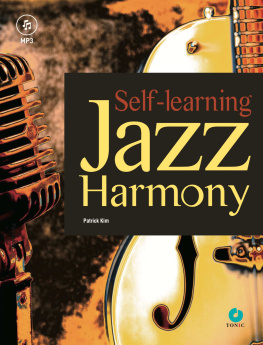
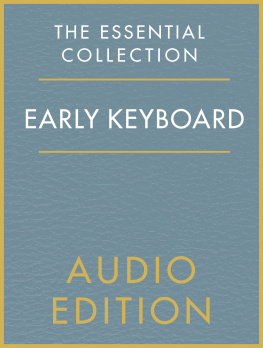
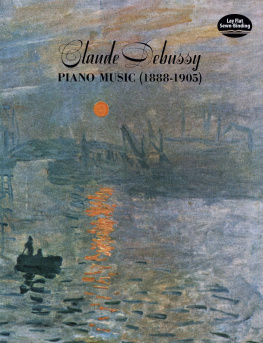

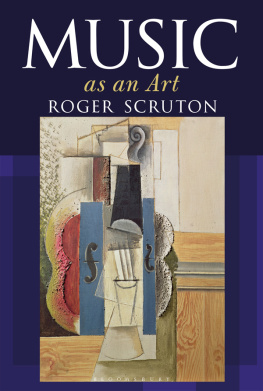

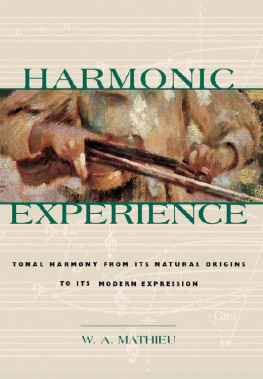



 ieur RAMEAU, Organi
ieur RAMEAU, Organi 
